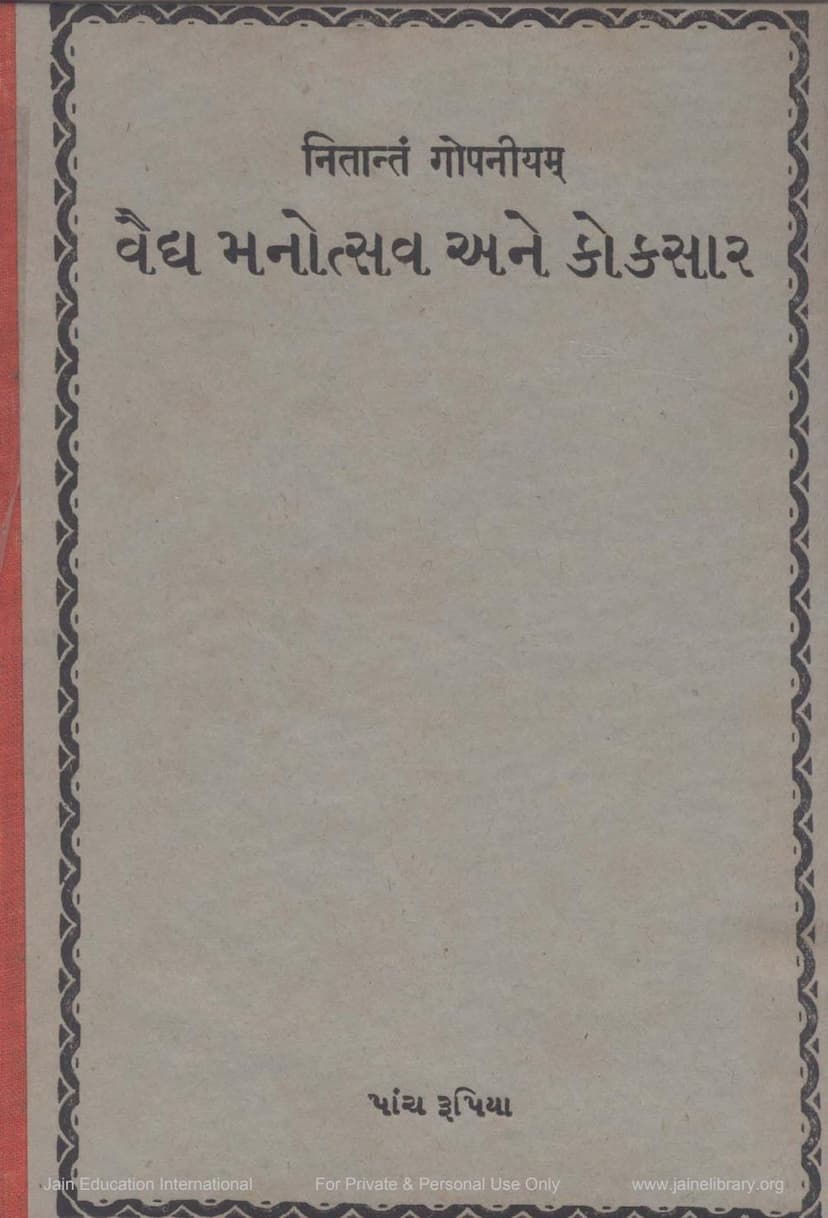Vaidya Manotsava Ane Koksar
Added to library: September 2, 2025
Loading image...

Summary
The book "Vaidya Manotsava ane Koksar" (વૈદ્ય મનોત્સવ અને કોકસાર) authored by Sarabhai Manilal Nawab is a compilation and presentation of two distinct ancient Indian texts.
Part 1: Vaidya Manotsava (વૈદ્ય મનોત્સવ)
- Author: Shravak Kavi NayanSukh (શ્રાવક કવિ નયનસુખ)
- Subject: This section is a comprehensive treatise on Ayurveda (Indian traditional medicine).
- Content: It covers a wide range of medical topics in a systematic manner, as indicated by the table of contents:
- First Chapter (Page 8-15): Focuses on pulse diagnosis (Nadi Pariksha), identifying diseases related to Vata (wind), Pitta (bile), and Kapha (phlegm), differentiating between curable (Sadhya) and incurable (Asadhya) conditions, and the concept of Kalachakra (time cycles in relation to health).
- Second Chapter (Page 16-26): Deals with the treatment of fevers (Jvara) of various types, diarrhea (Atisara), dysentery (Sangrahani), and related ailments. It details specific herbal remedies, formulations (like churnas, kashayas, and rasayanas), and their applications.
- Third Chapter (Page 27-33): Addresses conditions like hemorrhoids (Harsha), anal fistula (Bhagandar), abdominal masses (Gulma), inflammatory arthritis (Aamvata), intestinal worms (Krimi), abdominal pain (Shula), jaundice (Kamala), tuberculosis (Kshaya roga), and related treatments.
- Fourth Chapter (Page 34-37): Covers remedies for hiccups (Hichki), common cold and cough (Shardi, Khansi), respiratory issues like asthma (Swasa), indigestion (Mandagni), and cholera (Vishuchika).
- Fifth Chapter (Page 37-45): Discusses treatments for various skin conditions like ringworm (Kurand), urinary tract infections and related issues (Prameha, Mutrakrucch), skin diseases like eczema (Dadra, Vivichika), itching (Utata), swollen lymph nodes (Kanthmal), and injuries from weapons (Shastraghat).
- Sixth Chapter (Page 46-56): Covers diseases related to Vata, Pitta, and Kapha, oral hygiene, nasal disorders, ear problems, head ailments, migraines (Adhasi-si), and hair-related issues.
- Seventh Chapter (Page 57-66): Focuses on women's health, including menstrual issues (Pushpadharana), conception (Garbha dharana), general women's medicines (Stri Aushadh), techniques for sexual pleasure and enhancement (Stri Kashtimechan, Sankochan, Kuch kathin, Ling sthal, Stambhan), and aphrodisiacs (Kaam Gutika).
Part 2: Koksar (કોકસાર)
- Author: Kavi Anand (કવિ આનંદ)
- Subject: This section is dedicated to the art and science of love, romance, and sexual health (Kamashastra).
- Content: It delves into various aspects of human relationships and physical intimacy:
- Chapters 1-3 (Page 69-74): Describe the types of women (Ramanirup Varnan) based on their physical and psychological characteristics – Padmini, Chitrini, Shankhini, and Hastini, detailing their features and preferences.
- Chapter 4 (Page 74-76): Discusses the classification of men (Purush Gun Kathhan) into four types: Shashak (hare-like), Kurang (deer-like), Vrishabh (bull-like), and Ashva (horse-like), and describes their characteristics and temperaments. It also touches upon the types of heroes (Nayak Bhed).
- Chapter 5 (Page 76-80): Explores the stages of love and union (Rati Chandrakala) and various sentiments experienced during romance.
- Chapter 6 (Page 80-82): Covers the compatibility between different types of men and women in terms of their physical and emotional makeup (Ubhay Varnan).
- Chapter 7 (Page 82-85): Details the different stages of a woman's life and their inclinations towards love and romance (Vayasi Varnan).
- Chapter 8 (Page 85-89): Continues the exploration of romantic stages and emotions.
- Chapter 9 (Page 89-91): Discusses various forbidden relationships and their consequences (Agamya Pratyadi Karan).
- Chapter 10 (Page 91-108): Focuses on aphrodisiacs and techniques for sexual enhancement and stamina (Stambhanadi Aushadh Varnan), including methods for penis enlargement and tightening.
- Chapter 11 (Page 109-113): Explains methods of attracting or captivating partners (Nar Yuvati Vashikaran), including the use of amulets, mantras, and other techniques.
- Chapter 12 (Page 113-137): Describes various sexual positions (Aasan Bhed) for enhancing pleasure and intimacy.
Overall Context:
- Publisher: Sarabhai Manilal Nawab himself.
- Publication Year: Samvat 2002 (1946 CE).
- Purpose: The book was published with the intention of preserving these ancient texts, which were considered valuable but potentially endangered due to neglect. The editor, Sarabhai Manilal Nawab, expresses his pleasure in making these works accessible to the Jain community.
- Target Audience: Primarily intended for the Jain community, as stated in the preface.
- Note on Content: The preface acknowledges that the "Koksar" section deals with sensitive topics related to Kamashastra, and both texts are presented without commentary to preserve their original form.
- Monetary Value: The book was priced at five rupees, with a limited print run.
In essence, "Vaidya Manotsava ane Koksar" is a significant publication that brings together ancient medical knowledge and the classical Indian science of love and sexuality, making these traditional texts available to a wider audience, particularly within the Jain tradition.